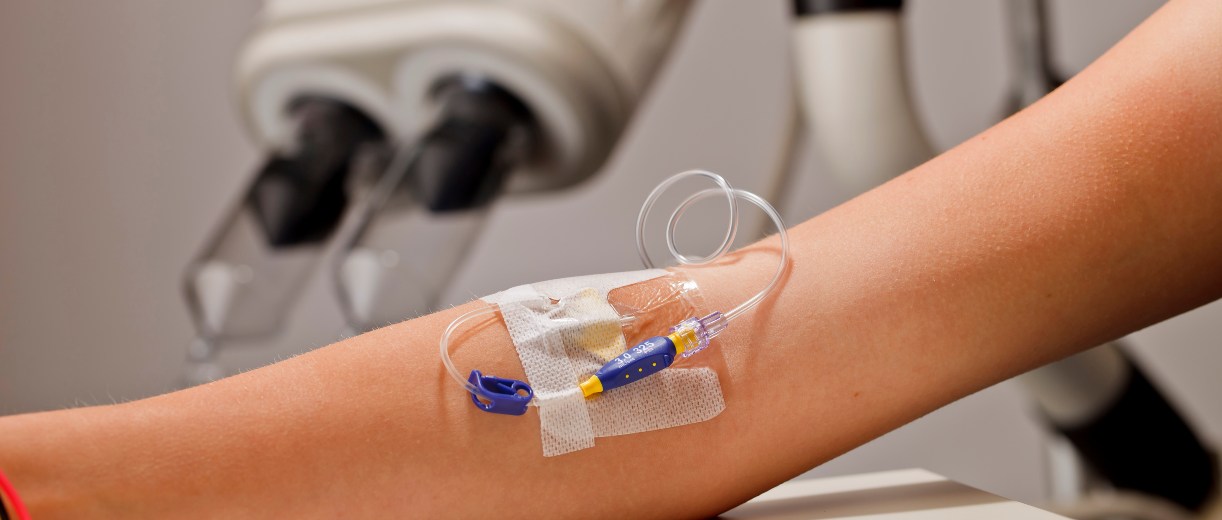CT scan contrast: How to help prevent extravasation
Intravenous (IV) injection of contrast media is frequently used for computerised tomography (CT) scans. CT scans may help clinicians detect tumours or evaluate vasculature before surgery.1
However, there is a risk of extravasation when injecting contrast media, especially in patients who have received chemotherapy.2
Extravasation from contrast media may occur when injecting large volumes or at fast rates through the infusion pump.2
More on this topic: Extravasation injury claims cost NHS £15.6 million
CT scan contrast and image quality
Good image quality depends on:3
- Intravascular contrast enhancement
- High-vessel attenuation
- Specific infusion flow rates
Total amount of iodine and iodine delivery rate determine contrast enhancement.3 Iodine delivery rate increases with higher concentrations of the contrast medium along with increasing injection flow rates.3
Higher flow rates have traditionally necessitated the use of large-gauge (i.e., 18 or 20 G) peripheral IV catheters (PIVCs).1,3 However, not all patients have the vasculature to support a large-gauge PIVC, especially older patients, obese patients and those with cancer.1,3
When a smaller gauge (i.e., 22 or 24 G) PIVC is placed, slower flow rates and reduced image quality may result.3 Another concern with smaller gauge PIVCs is that they may increase the risk of extravasation when injecting the contrast medium.4
More on this topic: Difficult IV access: Is ultrasound-guided cannulation the answer?
The use power injectors to infuse CT scan contrast
Power injectors may offer the following advantages when injecting contrast media intravenously:3
- Steady flow rate
- Automatic pressure adaptation
- Improved uniformity of contrast medium
- Consistent pressure
The choice of an appropriate PIVC
The selected PIVC should:
- Contain a diffusion catheter tip that enables the use of a smaller gauge for high-flow protocols (22 G up to 6.5 mL/sec), while still delivering the desired image quality.5
- Allow for a reduction in force to stabilise the catheter in the vein and prevent whipping, movement and backing out of the vein, which may reduce the motion effects that can lead to extravasation.6
- Be power injectable up to 325 psi.3
To find out more about an IV catheter that meets the criteria above, discover the BD Nexiva™ Diffusics™ Closed IV Catheter System and watch the video below.
References
- Tamura A, Kato K, Kamata M, et al. Selection of peripheral intravenous catheters with 24-gauge side-holes versus those with 22-gauge end-hole for MDCT: A prospective randomized study. Eur J Radiol. 2017;87:8-12. doi:10.1016/j.ejrad.2016.12.005
- Belzunegui T, Louis CJ, Torrededia L, Oteiza J. Extravasation of radiographic contrast material and compartment syndrome in the hand: a case report. Scand J Trauma Resusc Emerg Med. 2011;19:9. doi:10.1186/1757-7241-19-9
- Behrendt FF, Bruners P, Keil S, et al. Impact of different vein catheter sizes for mechanical power injection in CT: in vitro evaluation with use of a circulation phantom. Cardiovasc Intervent Radiol. 2009;32(1):25-31. doi:10.1007/s00270-008-9359-8
- Wienbeck S, Fischbach R, Kloska SP, et al. Prospective study of access site complications of automated contrast injection with peripheral venous access in MDCT. AJR Am J Roentgenol. 2010;195(4):825-829. doi:10.2214/AJR.09.3739
- Johnson PT, Christensen GM, Fishman EK. I.v. contrast administration with dual source 128-MDCT: a randomized controlled study comparing 18-gauge nonfenestrated and 20-gauge fenestrated catheters for catheter placement success, infusion rate, image quality, and complications. AJR Am J Roentgenol. 2014;202(6):1166-1170. doi:10.2214/AJR.13.11730
- Boschi R, Rostagno E. Extravasation of antineoplastic agents: prevention and treatments. Pediatr Rep. 2012;4(3):e28. doi:10.4081/pr.2012.e28
This list of references to third-party peer-reviewed material and the sites they are hosted on are provided for your reference and convenience only, and do not imply any review or endorsement of the material or any association with their operators. The Third-Party References (and the Web sites to which they link) may contain information that is inaccurate, incomplete, or outdated. Your access and use of the Third Party Sites (and any Web sites to which they link) is solely at your own risk.
![]()
BD-94027




